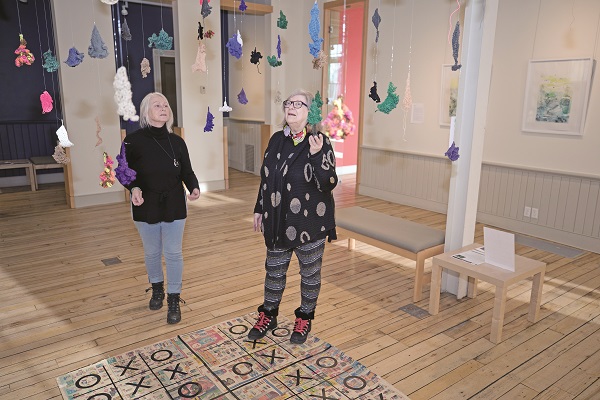Arts and Culture » General News » News
Science and art combine to sound environmental alarm bells
March 15, 2019 · 0 Comments

By Brock Weir
As a citizen scientist for a conservation authority near Lake Couchiching, Jennie Clark was tasked with documenting not only water quality, but the impacts of climate change on the surrounding area.
What Ms. Clark observed left a lasting impression, leaving her with the desire to do more – but it also left her with the big question of what can just one person do to have a lasting impact?
To answer that question, Ms. Clark went back to her roots, using her career as an artist to found the Simcoe Watershed Project, an artist collective focused on bringing creative minds together to use their talents to underscore concern for the lands and water of the Lake Simcoe and Lake Couchiching Watersheds.
The results of this collective, along with involvement from Lakehead University, can now be seen on the walls of the Aurora Cultural Centre in the new exhibition entitled “Watershedsci”, which opened Saturday.
Watershedsci responds “to the impact of environmental research documented by the dedicated scientists of Lakehead University, through artwork that responds to and honours the scientists’ work,” say curators.
The result is a thought-provoking exhibition by 12 artists working in a variety of media, including video installation, paintings and jewellery.
“This began as a group of artists interested in creating art that promoted the environmental health of the Lake Simcoe watershed and that came following an introduction I had to The Ladies of the Lake,” says Ms. Clark, referring to a group of more than 100 women who took action to have a positive impact on Lake Simcoe, beginning with a ‘cheeky’ calendar to raise both funds and awareness for the cause. “I began to think about how I, as an artist, could make a difference. I brought a group of my friends together who were interested in that and we started The Simcoe Watershed Art Project in 2011, and we have had a whole series of exhibitions since.”
The Lake Simcoe Watershed Art Project began to develop connections to the scientific world shortly thereafter when one member of the collective spotted an article in an Orillia newspaper highlighting research being done by Lakehead scientists that dovetailed with their concepts.
They contacted Dr. Sreekumari Kurissery with information about their project and found an instant connection.
“She brought together a panel of scientists who presented their papers, findings, photographs, and general information to a group of artists that we had invited to participate in the project,” Ms. Clark explains. “Those artists were selected based on their professional skills as art-makers, all popular art-makers within Simcoe County living within the watershed, who could relate to the findings the scientists were presenting. We wanted to keep it very, very local with artists working with the local university, showing at a local venue.”
The first show resulting from this partnership took place in Orillia, where it caught the attention of Clare Bolton, Gallery Manager for the Aurora Cultural Centre.
This version of the show, guest-curated by Judith Gibson-Vick, showcases 12 participating artists including Ms. Clark, Peter Miehm, Karen Wild, Roger Kerslake, Peter McEwen, Luci Dilkus and Heather Driver Kerslake, Bewabon Shilling and Tanya Cunnington, Joanna McEwen and Anton Pickard, and Sarah Uffelmann.
“Judith has managed to generate conversations between the art pieces and present them in an accessible way to the audience,” says Ms. Clark, paying special attention to an installation of several pieces of needlework suspended from the ceiling of the Cultural Centre’s Blue Gallery, which aims to highlight the growing problem of plastic and microfibres found suspended in the water.
“We talk about plastic bottles as being the most obvious problem, but much of our clothing is made out of polyesters and plastics, and they do not biodegrade; they just become part of the ecosystem and that is a very important issue.”
As she looks ahead to a series of events associated with Watershedsci, including talks with the artists and participating scientists, Ms. Clark says she hopes the dialogue between the works curated by Ms. Gibson-Vick helps spur further dialogue across the community.
“One measure of success is educational,” says Ms. Clark. “If children can come through the exhibit, respond to it, and if it can encourage conversation between teachers and students about some of these issues in a fun and positive way so that kids start thinking about it, that is a form of success. It’s also just stimulating a conversation about the subject, about environmental issues. It’s very timely. We’re all starting to realise that climate change is happening and we’re all starting to realise that sustainability is really, really important, taking care of the planet is really important, and getting those conversations going, even in a light-hearted way, is very important.”











